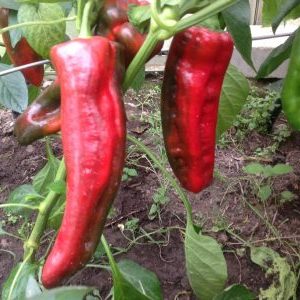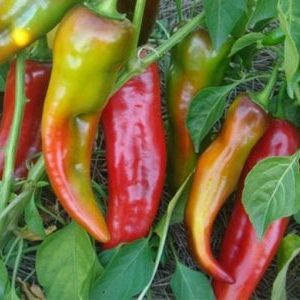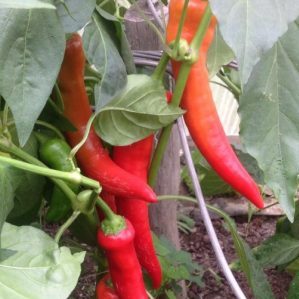Spectacular hybrid Kakadu pepper with an unusual appearance and pleasant sweet taste
In 2004, the register of breeding achievements of the Russian Federation was entered hybrid sweet pepper Cockatoo. It is distinguished by large fruits weighing up to 500 g and thick fleshy walls, high yield, versatility of use, excellent taste, as well as relatively unpretentious care. Let's get to know him in more detail later.
The content of the article
Feature and Description
Pepper bushes "Kakadu" look like compact trees... They practically do not branch in the lower part, and reach a height of one and a half meters. The stems and stem of the pepper contain a large amount of hard fibers, which makes them strong. Therefore, a garter is not needed for the hybrid, despite the height and spreading of the plant.
Cockatoo - mid-season pepper, 120-130 days pass from germination to fruiting. This hybrid can be used like any other sweet pepper. Fresh - for slicing and salads, eating stuffed. For the winter - for preparing blanks.
Attention! Cockatoo seeds cannot be collected for storage for next year, as this is a first generation hybrid (F1) and it is impossible to reproduce all its qualities.

Distinctive features
There are several main features that help distinguish the Cockatoo hybrid from the rest:
- Tallness. Cockatoo reaches 100-120 cm in height. Some plants even grow up to 1.5 m.
- Appearance. Fruits of exotic shape and bright color look beautiful and effective.
- Large-fruited. The fruits of this pepper can reach a length of 30 cm and a weight of 500 g.
- Productivity. Up to 2.5-3 kg of peppers are harvested from one Kakadu bush.
Characteristics of fruits, yield
The shape of the fruit resembles the beak of a cockatoo parrot, for which this pepper got its name. The pulp is fleshy, sweet and aromatic. The thickness of the walls reaches 1 cm, the length of the fruit is up to 35 cm, the weight is from 200 to 500 g. From one bush you can collect about 3 kg of the crop.
This is the only sweet pepper hybrid with a fruit shape like bitter - cylindrical and elongated. The color of the vegetable comes in two varieties - red and yellow.
Preparation for growing
To begin with, the seed is placed in a bowl with salted water. Quality seeds are heavy and will sink to the bottom. Lightweight ones will remain on the surface - this is a marriage, you should get rid of it.
Before sowing, the seeds are placed in a damp cloth and left in a warm room for a couple of days. The soil mixture should be loose and nutritious. You can buy special soil for growing peppers. If you take land from the garden in the fall, then it is important not to use it from the beds on which the nightshade grew.
Sowing is carried out from late February to early April, depending on the region. To do this, the seeds are buried 1.5-2 cm with an interval of 5 cm between plants. Cover with foil or glass and watered every morning.
After the emergence of shoots (7-10 days after sowing), the seedlings are rearranged in a bright place and, if necessary, use additional artificial light.
Growing seedlings
After the appearance of two true leaves, the plants are seated in different containers - peat pots or plastic cups. The third part of the root is removed. This technique is called a pick. For several days after this, the peppers must be protected from direct sunlight, then put them in a bright, cool place.
When sowing peppers immediately into separate containers, they do not need a pick. With the normal formation of seedlings, feeding is not needed. If there are problems, then they are fed with complex mineral fertilizers twice before planting in the ground.
The first time - after the pick, the second - two weeks after the first feeding, during the formation of the third leaf. Water in the morning as needed with settled water at room temperature.
Important! It is recommended to harden the peppers before planting them in the ground. To do this, the seedlings are taken out onto the balcony or street, increasing the duration of the plants being in the air every day.
Planting pepper
Peppers are planted in a permanent place when six or more true leaves appear. In the southern regions, this is mid-May and later, in the middle zone - until the end of June, so that the threat of frost passes.
At least a meter is left between the rows, 60 cm between the plants. The most convenient planting scheme is in a checkerboard pattern. Plants are planted in cloudy weather. If this is not possible, then early in the morning or in the evening, when the sun is not yet so active.
Wells 10-12 cm deep should be generously shed with water before and after planting. Plants are mulched with straw, peat or humus.
If the peppers are planted in a greenhouse, then they do it 2 months after germination. By this time, the plants have reached 30 cm in height and already have about 12 true leaves. The soil in the greenhouse should warm up to 15 degrees, that is, around May.
Further care
It is enough to water the Kakadu peppers once a week before flowering, 2 times - during the formation of fruits. Watering is stopped 10 days before harvesting. One plant accounts for 3 liters of water, after which loosening is carried out (so that a crust does not form) and mulching. In the greenhouse, watering is carried out every 2-3 days.
The first feeding is performed a couple of weeks after transplanting plants into open or greenhouse ground. To do this, mix poultry manure and water in a ratio of 1:15 or 1:20, or cow dung and water 1:10. Then they insist in a warm place until the end of fermentation and use 1 liter of fertilizer for each bush.
During the flowering period, spraying is carried out - 4 g of boric acid per 2 liters of water. After flowering, mineral fertilizer is applied under the peppers. To do this, mix 1 tsp. potassium sulfate and 2 tbsp. superphosphate and diluted in a bucket of water.
The last feeding is done when the fruit is ripe. Take 2 tsp for a bucket of water. potassium salt and superphosphate.
Important! All solutions are applied under the root of plants in the morning or evening, when the sun is not active.
Features of growing pepper and possible difficulties

Cockatoo is a tall pepper that needs to be considered when leaving. So that the plant does not grow and directs all its forces to the formation of fruits, and not stems, it must be properly formed. To do this, remove all lateral shoots up to the first fork, as well as all branches below the ovaries.
Choose a place for planting Cockatoo carefully. If this is open ground, then you need to find an area that is closed from possible gusts of wind. If the pepper is grown in a greenhouse, then it is planted so that tall plants do not block the light of other greenhouse crops.
Attention! If it is above + 30 ° C in the greenhouse, then pollination will not occur, and the flowers will crumble. Therefore, it is important to take care of ventilation. In hot weather, just open vents are not enough - you also need to raise the film sides.
So that the lower fruits of the pepper do not touch the ground, it is imperative that mulching is carried out with clean material. It will also retain moisture in the soil for a longer time and prevent weeds from germinating.
Typical diseases and pests
Pepper Cockatoo is rarely affected by diseases and pests, but every gardener needs to know about them.
- Fungal diseases (late blight). Prevention - 10-15 days after planting in the ground, spray with a solution of Bordeaux liquid. In case of defeat - "Oxyhom" and "Phytodoctor". In case of a strong defeat - "Ridomil Gold", "Barrier", "Zaslon".
- Aphids, spider mites, gall midges, wireworms, bear. Insecticides - "Fufanon", "Karbofos", "Actellik", "Phosbecid". Folk remedies - tobacco dust, infusion of garlic or onion peelings, water infusion of ash or tobacco. Fast decomposing insecticides - "Keltan" and "Karbofos".
- Apical rot of the fruit. Prevention - seed treatment with a solution of copper sulfate or potassium permanganate. Not only the plants themselves are processed, but also the soil under them, as well as the inner surfaces of the greenhouse. In case of defeat, spray with calcium nitrate.
Reference. Treatment with insecticides is carried out in the morning, before flowering, but not during the fruiting period of the pepper.
Advantages and disadvantages
Before purchasing Kakadu pepper seeds, you should familiarize yourself with its pros and cons.
Benefits:
- unusual appearance;
- pleasant sweet taste;
- high productivity;
- large-fruited;
- resistance to disease and temperature extremes;
- harvesting continues until late autumn (September-October).
Disadvantages:
- takes up a lot of space;
- tall, so it can reduce yields if it is crowded;
- in the open field, the wind can break off the shoots;
- the lower fruits may rest on the ground.
Read also:
The most delicious and simple pickled pepper recipes.
The variety that can become your favorite is the "Volovye ear" pepper.
Reviews

Reviews of Kakadu pepper are very controversial. Some gardeners are unhappy with the low yield and weight of the fruits, while others call grade one of the most beautiful and fruitful they have ever grown.
Larisa, Tula:“This year I started growing peppers for the first time. Bell pepper Kakadu was recommended to me by a seller at a local shop for summer residents. The pepper has a funny tip, reminiscent of the beak of a parrot of the same name. The fruits are juicy and tasty. True, the walls are not very thick. "
Diana, Serov: “I have been sowing pepper Cockatoo for several years now and I am happy with the result. The fruits are large, shiny, juicy and fragrant. They have thick walls and are well stored. Pepper begins to bear fruit in 2-3 weeks after planting in the ground! In a greenhouse or a greenhouse, I collect fruits until October, and they weigh 600 grams! I use cockatoo both for soups and salads, and for preparations for future use. Of 10 seeds, rarely 1-2 are found that are not viable. I am very pleased with the results! "
Camellia, Volgograd: "I bought Kakadu pepper seeds for 45 rubles. On the pack it is written 0.2 g, in pieces it turned out 39, of which 28 rose, but not one later died. I read on the Internet that the germination rate is 94%, I got 72%. The height is indicated as 1.5 m, I did not rise above a meter. The weight on the pack is 500 g, my largest was 380 g. The fruits are long, so the lower ones rest on the ground. But still the pepper is large and tasty, I plant it every year and recommend it to everyone. Of the minuses, I want to note the price. Also, Kakadu pepper is not suitable for stuffing because of its size and for collecting seeds. Pros - sweet and large, thick walls. I wish everyone a successful harvest! "
Conclusion
Pepper Cockatoo is a good choice for any summer resident. Its seeds sprout quickly, the plants are unpretentious and resistant even to the Ural and Siberian cold snaps and drafts. Large exotic fruits, rich harvest and excellent taste will satisfy the requirements of even the most fastidious gardener.